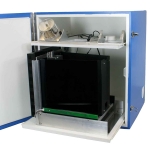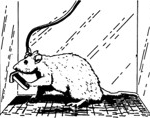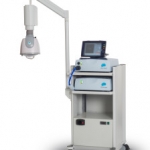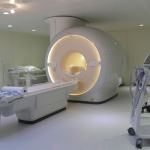The methods presented here are those unique to our lab or are not commonly used. We also utilize many other methods for the assessment of behavior, for electrophysiology analysis, or for molecular analysis.
Animal studies
Intracranial electrical stimulation (ICES) and recording of freely behaving animals – The lab is equipped with Stimulation and Recording System (SnR). The system is connected to bilateral linear microelectrode array (LMA), which allow both targeted stimulation and recordings from multiple locations. The LMA is implanted prior to the experiment, and recordings are conducted within a chamber enclose within a Faraday cage. This setup can be use in each of the below experiments.
Attention research
Five-choice serial-reaction time task (5-CSRTT) – The 5-CSRTT is conducted in 8 prebuilt trapezoid aluminum Bussey–Saksida touchscreen operant chambers for rats. These chambers are placed on an aluminum mesh and are covered with a Plexiglass cover. The front panel of the chamber (i.e., its wider side) contained five 1-cm deep apertures that the rat could nose-poke to establish contact with a specialized touchscreen placed behind the panel. The rear (narrow) panel of the chamber contained a ‘reward chamber’; a pump delivered the reinforcing sucrose solution into a small dip at the bottom of this chamber. A white LED bulb positioned above the ‘reward chamber’ is turned on in association with reward delivery. All operant chambers are kept in sound- and light-proof boxes equipped with house lights in the roof of the chamber, an audio loudspeaker (for delivery of the distractor during the distractibility test), and fans that provided a constant low-level white noise and airflow. The entire apparatus is operated, and task-related behaviors are monitored, through designated software (AbetII).

Addiction research
Self-administration (SA) chambers and the Conflict model – The lab is equipped with 12 standard SA chambers, controlled by a computer program. The chambers are equipped with two levers (active and inactive) on one side, and a red house-light on the other. A 7.5 mA white cue light and a 20 Hz cue tone (the drug-paired compound cues) are located above the active-lever and are activated concurrently with drug infusion. The ‘‘Electric Barrier’’ setup used for the conflict model is powered by serially connected rechargeable lead batteries (12 volts and 1.3 AH each) that are connected to approximately two-thirds of the grid floor adjacent to the levers. The electric intensity delivered to the barrier is manually controlled using an electric switch and increase by predefined algorithm. The remaining part of the chamber is considered the rat’s “safe zone”. The rat, nesting in the safe zone, must cross this barrier in order to lever press and gain the reward.

Conditioned place preference (CPP) – CPP is a standard preclinical behavioral model used to study the rewarding and aversive effects of drugs. Place preference conditioning is performed in 72×24.7×29.5 cm plastic boxes. Each box contained two distinct conditioning environments (24.7×30 cm) with a house light, separated by a narrow neutral zone (24.7×10 cm). The two conditioning environments differed in several aspects to allow rats to distinguish between the compartments.

Psychomotor Sensitization model – exploration boxes with computerized measurements of locomotion.
Depression research
Unique genetic model of depression – We commonly use a model of depression that was developed in our lab and include the Depressed Rat Line (DRL) and a complementary Motivated Rat Line (MRL). These are genetic-based models, in which rats undergo several tests for depressive-like behavior, ranked according to performances, and those which display the most depressive-like or the most motivated-like behaviors are inbred (see here for more information).
Chronic mild stress (CMS) – This is the most common model in the study of depression. In this environment-based model, depression is induced in wild-type rats following prolong exposure to unpredictable mild stressors.
Common evaluation methods – Forced swim test (FST) including video recording and unique computerized analysis of paw movements, sucrose preference (SP), exploration boxes with computerized measurements of locomotion, elevated plus maze (EPM).
Home-cage locomotion – Continues monitoring of locomotion in the home cage is performed using a computerized Inframot system, based on infrared sensors located 3 cm above the home cage of each rat.
Additional behavioral measurement methods in our lab
Morris water maze, elevated plus maze, exploration boxes with computerized measurements of locomotion.
Human studies
Deep TMS – The lab is equipped with all the apparatus needed for administration of dTMS in different fashions, including several different H-coils and paired associative stimulation (PAS) double coils as well as dual-channel stimulators. H-coils are used to target a specific brain area, while the PAS coils target two brain areas and stimulation is applied in specified intervals between these areas using a unique dual channel stimulator provided by Brainsway.

EEG – The lab is equipped with TMS-compatible EEG apparatus. EEG is recorded during resting state, performance of computerized tasks presented with E-PRIME, administration of single pulse or paired pulse dTMS, and during treatment.

Magnetic resonance imaging (MRI) – The scanner of the Soroka hospital is used for structural and functional analysis of the underline neuropathology, as well its reaction to dTMS treatment. Structural MRI and diffusion tensor imaging (DTI) is used for structural analysis, and functional MRI (fMRI) is recorded during rest and performance of computerized tasks before and after the dTMS interventions.

